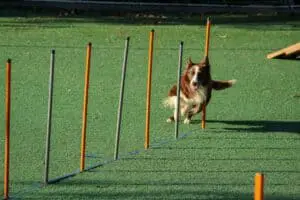Is training small dogs or training large dogs more difficult? Training a dog, regardless of its size, can be a challenging yet rewarding experience for both the owner and their canine companion. Small dogs and large dogs each come with their own unique set of challenges when it comes to training.

In this post, we will explore the differences between training small dogs versus large dogs, discuss the factors that make one more difficult than the other, and provide helpful tips to ensure a successful training experience for dogs of all sizes.
Training Your Dog
Training your pet is an essential part of responsible ownership. Well-behaved pets are not only easier to live with but also happier and healthier. However, training any animal can be challenging at times as there are numerous factors that affect their ability to learn new commands and follow them consistently.

One common belief is that smaller dogs are easier to train than larger ones simply because they’re smaller. On the other hand, some experts argue that larger dogs tend to be more obedient due to their desire for leadership from their owners.
But which one is true? Is there really any difference in how easy it is to train different sized dogs?
Importance of Choosing the Right Size Dog
Choosing the right size dog for your lifestyle and home environment goes beyond just personal preference. The size of your pet can have significant implications on both its behavior and training needs.

Small dogs typically need less exercise and space than larger ones, making them ideal for apartment living or households with limited outdoor areas. However, some small breeds can be stubborn or aggressive towards strangers if not properly trained and socialized early on.
On the other hand, larger breeds like Great Danes or Saint Bernards may require more physical activity and space but often have a calmer temperament and are more laid-back around children and other pets. Still, their size may pose challenges when it comes to obedience training and walking on a leash.
Brief Overview of the Factors that Affect Dog Training
The ease or difficulty of training your pet is influenced by several factors, including its age, breed characteristics, temperament, and your chosen training method. Puppies tend to be more receptive to learning new commands but may also have shorter attention spans.
Some breeds, such as hunting dogs or guard dogs, require specialized training to fulfill their innate instincts. A dog’s individual disposition also plays a role in its ability to follow instructions.
Your chosen training approach can make all the difference in how quickly and efficiently your pet learns new things. Positive reinforcement techniques are considered the most effective way of teaching animals new behaviors while avoiding punishment-based methods that can harm the animal’s well-being.

Understanding the differences between small and large dogs’ behavior tendencies can help you make an informed decision when choosing your next furry friend. However, whether it’s easier or harder to train one size over another depends on various factors that will be explored in detail throughout this article.
Factors Affecting Training
Training a dog, regardless of size, is a task that requires time, patience, and consistency. However, different factors can impact training effectiveness. Understanding these factors can help you choose the right size and breed of dog for your lifestyle and improve your training efforts.
Size and Breed Characteristics
Size matters when it comes to dog training. Small dogs are typically easier to manage than large dogs as they require less space and are easier to control in public areas.
Additionally, small dogs tend to have shorter attention spans but can be trained more easily with positive reinforcement techniques like clicker training. Breed characteristics also play a role in how easily a dog can be trained.
Each breed has its own unique set of personality traits that affect its ability to learn commands. For example, some breeds like Border Collies are highly intelligent and trainable while others like Bulldogs may be more stubborn and require additional effort.
Age and Temperament
A dog’s age is another factor that affects its ability to learn new commands. Generally speaking, puppies have shorter attention spans but can learn quickly through consistent training methods such as positive reinforcement techniques.
Older dogs may take longer to grasp new concepts but can still learn with patience and persistence. Temperament is also an important factor when it comes to training effectiveness.
Some dogs are naturally anxious or aggressive which may hinder their ability to respond well during training sessions. These temperament issues must be addressed before beginning any kind of obedience training.
Training Methods
The methods used during obedience training play a vital role in the success of the process regardless of the size or breed of the dog being trained. Positive reinforcement techniques such as praise or treats for good behavior have been proven effective at helping dogs learn faster than punishment-based methods like scolding or physical correction. Also important is consistency in the commands used and the rewards offered.
Dogs learn through repetition, so using consistent commands and rewarding good behavior regularly is key to successful training. Additionally, taking a break during sessions when a dog becomes frustrated can help prevent negative associations with training and keep the experience positive for both you and your furry friend.
Training Small Dogs
Advantages and Disadvantages
Small dogs can be adorable, but they come with both advantages and disadvantages when it comes to training. One of the biggest advantages is their size, as they require less space to move around in and tend to have lower exercise needs compared to larger breeds.
However, small dogs can be prone to behavioral issues such as barking excessively or showing aggression towards other dogs. Another issue when training small dogs is that some owners underestimate the amount of time and effort needed for effective training.
As a result, some small dogs are not trained well enough, leading to behavior problems later on in life. It is important for owners of small dogs to understand that even though they may be smaller in size, they still require proper training.
Size and Space Requirements
When it comes to size and space requirements for small dog breeds, it is important for owners to consider the overall living situation. Small dog breeds such as Chihuahuas or Pomeranians are suitable for apartments or smaller homes where larger breeds would feel cramped. This makes them ideal pets for those who live in urban areas or do not have access to large amounts of outdoor space.
However, it is crucial not only to consider the living space but also the amount of physical activity required by different breeds. For example, some small dog breeds such as Jack Russell Terriers require more exercise than others like Pugs or Shih Tzus.
Behavioral Issues and Exercise Needs
Small dog breeds are known for having a big personality despite their tiny stature which can lead them into trouble if not properly socialized during their early years. They may become aggressive towards other pets or people when feeling threatened by unfamiliar situations.
Exercise needs also vary with different types of small dog breed; some need daily walks while others prefer playing indoor games or running around in the yard. Owners should consider the exercise needs of the breed and create a routine that will satisfy both their physical and mental needs.
Training Tips for Small Dogs
When it comes to training small dogs, it is crucial to use positive reinforcement techniques such as giving verbal praise or offering a treat when they perform a desired behavior. Consistency in commands is also important as small dogs can get confused or even anxious when commands change too often.
One way to achieve consistency is by using short, clear commands that are easy for the dog to understand. Owners of small dogs should also be patient during training sessions, as smaller breeds may take longer to learn new behaviors than larger ones.
It is crucial to keep training sessions short and fun, without overwhelming the dog with too much information at once. Small dogs come with their own set of advantages and disadvantages when it comes to training.
Owners should consider size and space requirements, behavioral issues, exercise needs, and use positive reinforcement techniques consistently during training sessions. With patience and dedication from both owner and pet alike, even small dogs can become well-trained companions with good behavior.
Training a Large Dog
Large dogs are often viewed as intimidating, but they can make great companions. However, training them can be a daunting task.
It is important to understand the unique characteristics of large dogs and the challenges that come with their size when it comes to training. In this section, we will explore the advantages and disadvantages of training a large dog, their size and space requirements, behavioral issues that may arise during training, exercise needs, and tips for effective training.
Advantages and Disadvantages
One advantage of having a large dog is the sense of security they can provide as a watchdog or guard dog. They are also great for outdoor activities like hiking or running due to their stamina and energy levels.
On the other hand, their size can pose challenges for owners who live in apartments or small living spaces. Large dogs require more room to move around comfortably and may damage furniture or property if they do not have enough space.
Size and Space Requirements
The size and space requirements for large dogs are greater than those of smaller breeds. They need ample space to move around freely without feeling cramped or restricted.
A backyard is often necessary for these dogs to run around in or play fetch without being confined indoors all day long. Additionally, larger breeds require bigger beds/crates that need maintenance.
Behavioral Issues
Some behavioral issues common among larger breeds include aggression towards other animals or people due to poor socialization early on in life or dominance over their owners if not trained properly from an early age. These issues can pose significant challenges during training sessions.
Exercise Needs
Large breed dogs have high energy levels that require regular exercise through activities like walking, running, playing fetch/tug-of-war games, etc. Exercise helps prevent obesity-related health problems such as joint pain or hip dysplasia that are commonly found in larger dog breeds.
Training Tips for Large Dogs
Effective training of large dogs requires patience and consistency. Positive reinforcement techniques should be used to encourage desired behaviors and discourage unwanted ones.
Consistent commands and rewards help the dog understand what is expected of them, which results in quicker training times. The key to effectively train a large breed dog is to stay calm, assertive, and patient throughout the entire process.
Conclusion:
Summary of main points:
Throughout this article, we have explored the different factors that can affect the training of small and large dogs. Size and breed characteristics, age, temperament, and training methods all play a significant role in the success of training.
Small dogs have advantages in terms of space requirements, while larger dogs may require more exercise. Additionally, both small and large dogs can present behavioral challenges that need to be addressed during training.
Factors to consider when choosing a dog size:
When deciding between a small or large dog, it’s essential to consider your lifestyle and living situation carefully. If you live in an apartment with limited space or want a dog companion for couch cuddles, a small dog may be more suitable for you.
On the other hand, if you have a big yard or enjoy outdoor activities such as hiking or running with your dog, a larger breed may be more appropriate. It’s also crucial to research individual breeds’ characteristics and temperaments before making a decision.
For example, some smaller breeds are prone to excessive barking or aggression towards strangers. Similarly, some larger breeds may have high energy levels that require daily exercise and mental stimulation.
Importance of patience, consistency and positive reinforcement in training any size dog:
Regardless of whether you choose to train a small or large dog breed, patience is key when undertaking this task. Dogs learn at their own pace; thus progress may take longer than expected at times.
Consistency is also important; using the same commands consistently will help prevent confusion on your pet’s part. , positive reinforcement is another crucial element in successful training- praising them for good behavior instead of punishing them for bad behavior makes for faster learning experience, improve their confidence,and helps build trust between you two.
, it’s not necessarily more difficult to train a small versus large dog, but rather, each presents its unique challenges. By considering the factors outlined above and practicing patience, consistency, and positive reinforcement during training, both small and large dogs can be excellent companions that thrive in any living situation.



